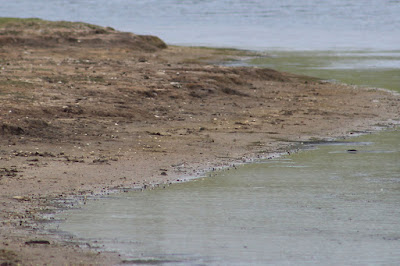Annie and I celebrated our 25th wedding anniversary last Tuesday and because it was a landmark day and not being the big party-types I arranged for us to stay at La Grenouillere, near Montreuil-sur-Mer, about 10 miles inland from Le Touquet.
La Grenouilerre is something out of the ordinary. For one thing the decor has a particular theme – frogs. There's frogs on frescos in the anti-room, plus a prominent scultpure in the garden. There is an obvious reason – if you speak French at least – as a grenouillere is a swamp where frogs live (or something like that).
 |
| The pathway from the restaurant to our accomodation |
 |
| View from the cabin |
It has two Michelin stars and is run by one of France's best and most innovative chefs, Alexandre Gauthier. Gauthier is renowned for focusing on nature, his menu features imaginative ingredients from the surrounding countryside. And he loves pepper. Pepper is often a feature – including in ice.
Set in the Canche river valley below the walled town of Montreuil, there are a number of guest rooms and cabins on site, one of which we booked for two nights. These cabins are set deep into the unspoilt grounds, and you feel genuinely at one with nature in amongst the shrubbery. It is peaceful, tranquil and the perfect environment to relax.
 |
| The kitchen of Alexandre Gauthier |
It also helped that we timed our two-night visit for the two hottest days of August. Perfect.
La Grenoulliere features two striking metallic marquees that extend out into the garden from the century-old main buildings, and were designed by architect Patrick Bouchain. This radical juxtaposition of old and new is in keeping with the cuisine.
 |
| The restaurant |
 |
| Sea Bream - one of the tasting highlights |
The restaurant, from which you can watch Gauthier and his team prepare the dishes, serves a radical
cuisine in a minimalist, spacious environment with just a few tables. It a very relaxed place to eat. Nothing here is austere – feel free to wear jeans if you want – this is a place to enjoy excellent food.
 |
| The dessert wine is served |
We went for the eight-course tasting menu with accompanying wines (decent sized glasses they were too! The honey-based dessert wine came in a huge glass bowl and the wine was siphoned into a large pipette before being served). The food was amazing. It including melon and langoustine, sea bream, a river fish (a poisonous one), courgette prepared in a way that is remarkable, crab, chicken with verveine, we also had additional mushrooms picked that day in the surrounding woodland, plus honeycomb, strawberries and rhubarb like I've never tasted before.
And in between we tasted all manner of interesting delicate sensory delights including samphire, a flower that tasted of truffle, quail eggs, apricot mousse in a casing that dissolved in the mouth, all subtle but fascinating. The courses were small but even I was full by the end of the meal.
So we ate well and drank fabulous wine.
And I saw a Honey-buzzard.
 |
| Honey-buzzard! |
On the first day, as we chilled out in the late afternoon sun outside the cabin, I noticed a large bird being mobbed by Swallows and House Martins. At first glance, as it flew behind a tree, I thought it was a heron as it had large wings. I managed to get my bins on to it and immediately could see it was a buzzard. It looked different, and when it called it didn't sound like a Common Buzzard.
Having been to this area a couple of months earlier and drawn a blank with Honey-buzzard, I was really hoping this would be one, as despite being birding for some years now I have never seen one.
Looking at it closely I felt 80 per cent confident, but I've made mistakes before. I managed a few record shots, but only after I was forced to switch off the autofocus which had frustratingly decided not to work.
As it drifted off I looked at the images on the camera – I was still not 100 per cent sure, and it was only after getting home and blowing up the images that I become more confident. The two bands on the tail and the general jizz pretty much nailed it for me, but to be certain I sent the images to David Campbell to check for me. And thankfully, he immediately replied and confirmed that it was, indeed, a Honey-buzzard
The perfect end to a fabulous couple of days!



























